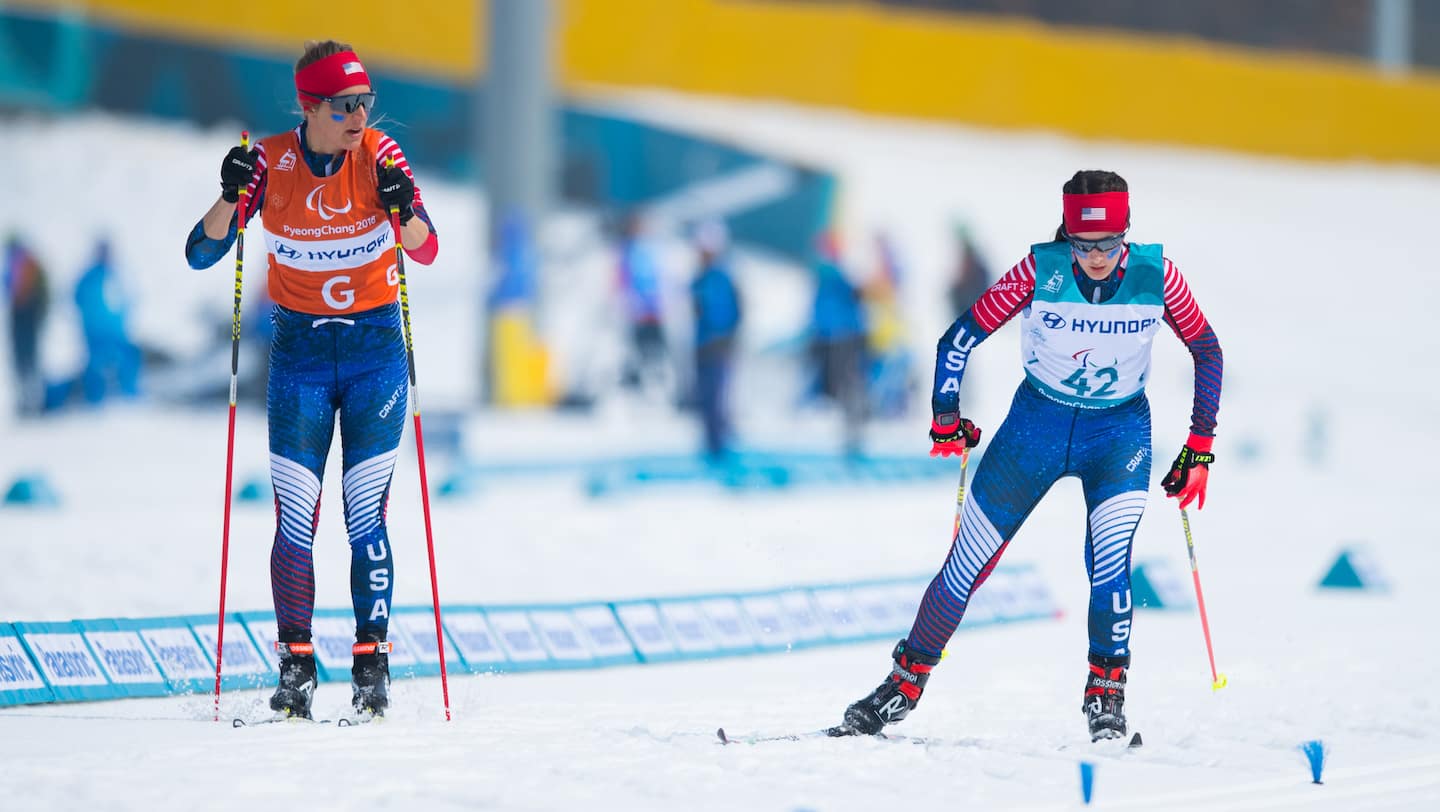
Visually Impaired Nordic Skiers Form Tight Bonds With Guides
by Alex Abrams

Mia Zutter competes in PyeongChang. (Photo: Mark Reis)
Max Nelson relies on a personal guide to help direct him when he’s running on grass with his high school cross country team. Nelson is blind in his left eye, and he can see only about 25-to-30 percent out of his right eye. He has no peripheral vision.
Nelson’s guide helps by running with him during cross country races. They’re tethered to each other by a bungee cord, and they’re always within arm’s reach.
However, Nelson has to essentially cut the cord when he competes in Para Nordic skiing. He still has a guide who steers him around the course, but they aren’t physically connected like they are when he runs.
“It definitely took some getting used to because we weren’t attached, but over the years I’ve gotten really used to it,” Nelson said. “Honestly, I’m not a fan of the tether. In Nordic skiing, I would definitely not want to be tethered to someone.”
For visually impaired athletes like Nelson, Para Nordic skiing is more of a team sport than a solo event.They must form a bond with their guides, who ski a few feet in front of them and give verbal cues on what’s coming up ahead of them on the course.
Skiers and guides must figure out an effective way to communicate during a race, but things can get tricky.Visually impaired skiers don’t always have the same guide for every race. They sometimes have to tell a guide they just met what sort of verbal cues would help them ski faster and avoid crashes.
“I would say it’s 100 percent a team kind of relationship, because I couldn’t be out there doing what I’m doing without (my guide), and the same with her,” said Mia Zutter, a visually impaired skier who made her Winter Paralympic debut at the 2018 PyeongChang Games.
“I mean, she wouldn’t have had that opportunity without me, so it definitely feels really like a mutual excitement,” Zutter said. “With some of my favorite guides, it feels like a friendship and a companionship. So it’s not like I feel like she’s my coach. It’s more like a really equal relationship.”
Zutter was diagnosed at age 12 with Stargardt disease, which is an inherited disorder of the retina.She said her vision is now like looking through sea glass or a fogged bottle.
When Zutter is competing in a race and approaches a turn that curves left, she said she likes for her guide to repeat the word “left” as many times as it takes for the guide to make the turn with her skis.
That helps Zutter figure out how to make the turn herself.
“I think something that I look for specifically is somebody who’s not trying to coach me while I’m skiing, especially in a race,” Zutter said.
Because Nelson doesn’t have any peripheral vision, he said he needs his guide to call out if they’re passing another skier on his left or right side. Nelson said he also wants his guide to inform him when they’re approaching a steep downhill section on the course or if there’s a ski pole on the ground that could trip him.
Guides often wear headsets and have speakers mounted on their backs to help amplify their voices when they’re giving verbal cues to skiers following them during a race.Visually impaired skiers, meanwhile, don’t wear headsets. They instead must listen for cues from their guides without the benefit of technology.
In March, Nelson competed with several members of the U.S. Paralympics Nordic Skiing national team at a world cup event in Slovenia. He said his guide had a loud enough voice that he didn’t need to use a headset and speaker for Nelson to hear him.
Despite all the noise at a race, Zutter said it’s not difficult to differentiate the verbal cues that her guide is giving from those coming from another skier’s guide.
“As a visually impaired person, I’m really keen to voices, so that’s obviously a cue for me,” Zutter said. “Also, I do have enough vision to tell which guide is mine, especially (with her wearing) bright colored uniforms.
“I use that as a cue, and she’s never too far in front of me where I’m completely like ‘Where the (heck) did she go?’”
Guides can also lend a helping hand on occasion.When visually impaired skiers are going downhill, they’re allowed to get what’s referred to as a pole hold or a pole assist. They can reach out and grab one of their guide’s ski poles and get help making it down the hill without crashing.
For that moment, they’re allowed to be connected to each other.
“Your guide works with you. You work as a team out there to get … fast as possible,” Nelson said. “So yeah, it’s definitely a team thing.”